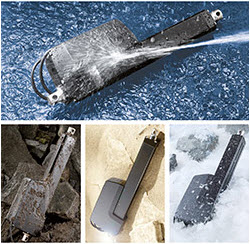Read more about Agri Automation? Enter your e-mail address here and you will receive the PDF.
Research These Five Elements To Properly Design Your Machines For Harsh Conditions
Research These Five Elements To Properly Design Your Machines For Harsh Conditions
Machine designers for heavy duty applications know how important it is to select motion control components that can withstand even the harshest conditions. To help with this process, a recent research presented five elements designers must keep in mind that contribute to robust operation:
– Material selection
– Coatings
– Sealing strategy
– Vibration/shock resistance
– Maintainability

Factor One: Material Selection
New alloys and hybrid materials can withstand extreme temperatures, exposure to chemicals or abrasive materials, frequent washdown, and other environmental forces. Stainless steel, hard-anodised aluminium and resistant polymers are among the most popularly deployed materials used to ruggedise motion control components.
Poor material selection will result in premature failures, expensive in-field service and repair, and lost productivity. Maximum protection comes when all motion control components – from the actuator housing to the smallest bearing – are selected with worst case operating scenarios in mind.
Factor Two: Coatings
Durable coating of the actuators successfully protects their internal components
Motion control components used in extremely corrosive environments should also be coated with high-performance materials. This improves operation and reduces downtime, especially in environments where corrosive chemicals, salt spray or submersion will require additional protection. The right coating and material combination can extend component life 200-fold.
Factor Three: Sealing Strategies
Unless a component is adequately sealed, chemicals and particulates can get into internal component mechanisms, causing damage, build-up and clogging, creating fertile ground for microbial growth. Deploying inadequately sealed motion control technology in harsh environments will require additional cost of enclosures and maintenance, and potentially more frequent maintenance.
Every component should be sealed, including motor mounts. Wipers, seals and gaskets are integral to success. The wiper brushes contaminants from the extension tube during operation and prevents water intrusion. The seals back up the wipers. Gaskets provide sealing between housings, cover tubes, motors and rear mounting components.
One of the best indicators of a system’s sealing effectiveness is International Protection Marking, or IP Code. Its ingress protection (IP) rating is the global standard for measuring protection from the ingress of solid objects and liquids. The IP rating specifies the degree of environmental protection an enclosure provides against foreign materials that could impact performance.
Factor Four: Vibration And Shock Resistance
Operating in harsh conditions often requires ability to handle heavy loads or withstand sustained forces such as intense vibration. Constant torque and movement weaken a component over time, cause failure and may often require accommodations by product manufacturers.
Planetary gear designs provide more shock resistance than parallel gearing. Cutting one internal gear directly into the output housing improves stiffness. Leveraging a single-piece housing and ring gear, in this way, eliminates gear slippage inside the housing, offering higher peak torque. Avoiding bushings with rolling elements can also help systems handle constant stress, as can depth/through case hardening of shafting. Proper mating of all components is also critical to shock protection.
Factor Five: Maintainability
Components that require minimal maintenance improve employee safety and minimise potential for workplace accidents, while reducing costs. Lubrication is a key maintenance driver for motion control systems. Components that pre-lubricate with grease or self-lubricate can greatly reduce or eliminate ongoing maintenance demands. However, products that use oil for lubrication, however, require more maintenance and present greater risk to human safety.
Motion control technology can reduce the need for human exposure, while at the same time, enabling performance of operations beyond human capability. However mechanical components require protection too, and careful consideration of materials, coatings, sealing strategies, vibration and shock resistance, and maintainability can help system designers ensure they will get maximum performance and life out of the systems they intend to deploy in challenging environments.
